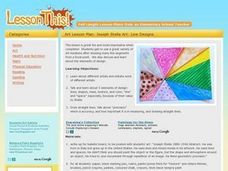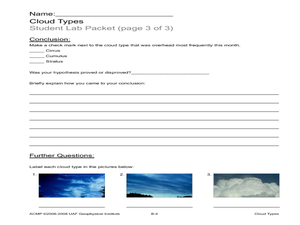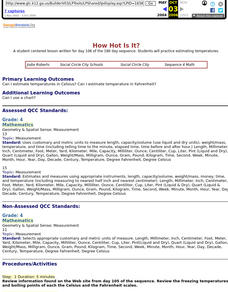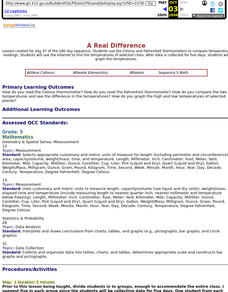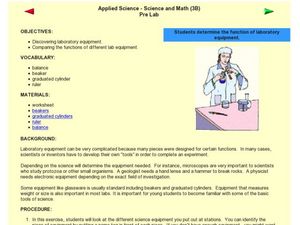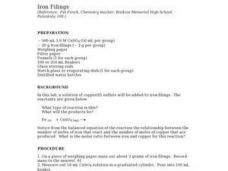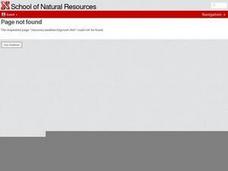Curated OER
Literal Equations
Students explore Literal Equations. In this literal equations lesson plan, students use the Internet to connect to links and solve linear equations. Students investigate, analyze and record their findings on various activity worksheets.
Curated OER
Jupiter's Weather Forecast
Students read information about Jupiter and the planet's weather. In this Jupiter weather lesson plan, students read information about Jupiter's weather. Students study a chart about the weather on Earth and Jupiter. Students read a...
Curated OER
History of Atomic Theory
Young scholars study the significance of the quantum model and how scientific theories adapt over time. In this investigative lesson students describe the contributions that scientists have helped develop the atomic theory and...
Curated OER
The Day the Atom Died (Grade K-1)
Students investigate what is wrong with the Rutherford atomic model. For this chemistry lesson, students answer questions about the atomic model after watching a video. They draw conclusions from the video and discuss how the atomic...
Curated OER
Joseph Stella Art: Line Designs
Students discover the focal point in pictures and create their own images using lines and space. In this art analysis instructional activity, students create a black dot on a white paper which becomes a focal point for the lines...
Curated OER
Classroom Management Using Gandhian and Kingian Principles of Nonviolence
Tenth graders study the concept of civil disobedience. In this Current Events lesson, 10th graders participate in a survey that nominates students for hard work and exemplifies nonviolence.
Curated OER
Impulse/Momentum Lab
Students investigate the relationship between force and momentum using motion detectors and sensors. In this physics lesson, students graph experimental results. They calculate impulse using the area under the graph.
Curated OER
Dimensional Analysis Problem Set
Students, after studying various pages of a NASA Web-based textbook, use dimensional analysis to verify actual aeronautic equations.
Curated OER
How High Does the Atmosphere Go?
Students explain how relatively thin the atmosphere is, compared to the size of the planet, and determine the relative extent of the four major atmospheric layers.
Curated OER
Bounce!
Learners investigate the relationship between potential and kinetic energy. In this energy lesson plan students investigate the height a ball will bounce when dropped from various heights.
Curated OER
Cloud Types
Students examine cloud types. In this cloud lesson, students identify cloud types, observe clouds and collect data, and analyze data to identify the most common cloud they observe overhead during the course of a month.
Curated OER
Saltwater Science
Students conduct an experiment that shows them how salt water allows things to float. In this salt water lesson plan, students mix ingredients together to create salt water and observe how it makes the oceans dense. They then interpret...
Curated OER
You Are What You Eat: Plastics and Marine Life
Young scholars study the different types of plastics and see which ones sink or remain buoyant. In this ocean environmental lesson plan students complete several handouts, and view a film on PBS.
Curated OER
How Hot Is It?
Fourth graders practice estimating temperatures. They practice in Celsius and Fahrenheit.
Curated OER
Mathematical Techniques - Basic Graphing
Young scholars are introduced to significant figures and how to add, subtract, multiply and divide them. In a group, they practice plotting data points from a table to a graph and labeling all axes. They calculate the slope and...
Curated OER
A Real Difference
Fifth graders use the Celsius and Fahrenheit thermometers to compare temperature readings. They use the Internet to find the temperatures of selected cities. After data is collected for five days, 5th graders graph the temperatures.
Curated OER
Get Down With Density
Students define density and observe that things that are less dense than water will float. Students find the density of copper, iron and aluminum
Curated OER
Investigation of Hooke's Law Lab
Students determine the spring constant by conducting an investigation. In this physics lesson, students collect data and create a graph of force vs. displacement. They compare the results of two different methods to find spring constant.
Curated OER
Applied Science -- Science and Math (3B) Pre Lab
Set up stations around your science lab to introduce youngsters to different equipment. They examine a beaker, graduated cylinder, ruler, balance, and thermometer. The said worksheet is not included, but you will find a few useful tips...
Curated OER
Iron Filings
Students conduct an experiment in which a solution of copper(II) sulfate is added to iron filings. They write and balance the equation for the reaction that occurs and calculate the amount of iron that reacted and the percent yield of...
Curated OER
Kinetic Energy and Work
High schoolers study kinetic energy and how it works. In this investigative activity students divide into groups and attempt to break a board with their hand.
Curated OER
Impulse and Momentum
Learners are introduced to the concepts of impulse and momentum and problem solving strategies for these types of problems. In groups, they discover the law of conservation of momentum and share their answers with the class.
Curated OER
The Big Crush
Middle schoolers examine weather maps from their state from the past few days. They examine the Highs and Lows on the maps to determine what kind of weather they produce. They use that information to better prepare for their activities...
Curated OER
Air Expansion and Contraction
Pupils observe that air exerts pressure, that heated air expands and that cooled air contracts. After the demonstration, students engage in a question and answer session about what they saw.
Other popular searches
- Measuring Mass of Balloons
- Measuring Mass and Weight
- Measuring Mass and Volume
- Measuring Mass Activity
- Tools for Measuring Mass
- Measuring Mass Triple Beam
- Measuring Mass Stations
- Measuring Mass With Scale
- Measuring Mass Biology
- Measuring Mass Centers
- Measuring Mass Worksheet
- Measuring Mass Math




